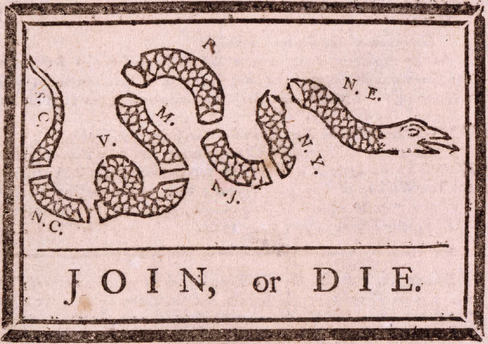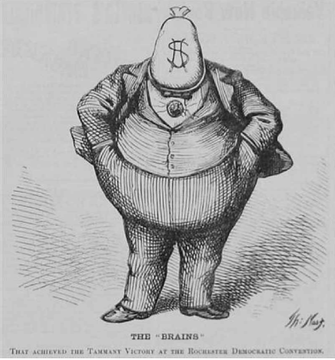|
The impact of political cartoons is often overlooked by the public, but has been long feared by politicians. "Political cartoons began as a street-level phenomenon. In the late eighteenth and early nineteenth centuries, they were often posted on walls or passed from person to person, as well as being published in newspapers. In the end of the nineteenth century, they were an important part of the growing popularity of newspapers and magazines, and the intense competition for readership made provocative cartoons a valuable selling point." |
"Benjamin Franklin's warning to the British colonies in America "join or die," exhorting them to unite against the French and the Natives, shows a segmented snake..." [sic] [4]
|
|
These provocative cartoons exposed important dealings to the people, but at the expense of of politicians. As Chris Lamb described, "Politicians and other influential figures have tried to silence editorial cartoonists for as long as the country has existed. It was, of course, the corrupt New York City Tammany Hall political boss William Tweed who summarized the simple potency of the political cartoon by saying: 'Let's stop them damned pictures. I don't care what the papers write about me- my constituents can't read; but damn it, they can see pictures!'" [3] |
"Nast, 'The Brains' That Achieved the Tammany Victory at the Rochester Democratic Convention" [3]
|
“Cartoons are not meant to make people comfortable, validate established views, or maintain the status quo. Instead they raise difficult issues that are the subject of public debate. In a way they function as a public conscience.” Cartoonists exposed their findings through purposeful satire. "Satire is intended to shake us out of our apathy or sense of indifference and bring about reform." [3] As Herbert Block himself said, "I still feel that the political cartoon should have a view to express, that it should have some purpose beyond the chuckle." [6]
|
“Political cartooning in our country is divided into basically two groups: Those like Herblock, who think that political cartooning is serious work, who don't shy away from doing a cartoon that's sad or poignant. The other group thinks that the primary role of cartooning is to provide laughter. It's not like they're two distinct groups; it's just that people like Herblock are not afraid of making their point in the absence of humor, if that's what it took.” - Cartoonist Tony Auth [7]



